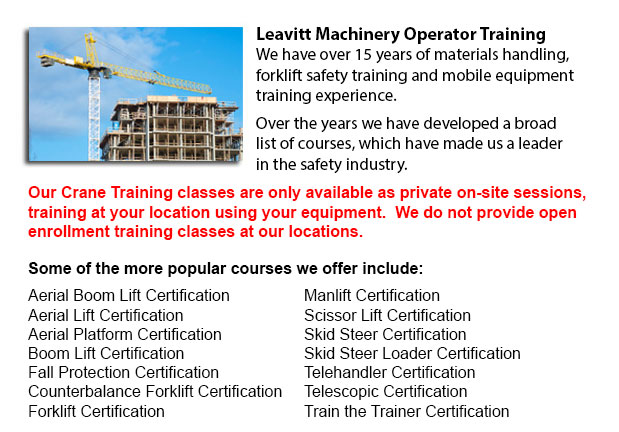
Toronto Overhead Crane Operator Training - The course teaching overhead crane operator training has been designed specially to instruct trainees on the basics of pre-shift inspections and overhead crane/sling operation. The courses are instructed by professional trainers and consultants. Well-trained staff are more efficient and productive, which saves on costs connected with product damage, property damage, and accidents due to the utilization of incorrect operating procedures. Our overhead crane certification is customized for workers who have literacy barriers, reducing certification time by 50 percent.
Overhead cranes are suitable for particular repetitive hoisting activities. This type of crane has wide ranging capacities. They may be used for specialized hoisting tasks like removing or installing major plant equipment.
To safely utilize an overhead crane, employees need to employ safe rigging practices. This requires both practice and knowledge. The load must be rigged properly to be able to guarantee its stability when lifted. Prior to beginning a hoisting job, it must be determined that the crane is right for the job, with right travel, lift and capacity. The crane should be subjected to a thorough physical and visual check before use. The capacity of all equipment, including the slings, hardware and rope, must never go beyond load weight capacities.
Prior to using the rigger should know what sling is best for each lift and must inspect the rigging hardware and gear. The communications that are used with the crane operator must be concise and clear. A signaler should be designated for the role and signals must be agreed upon. The operator of the crane must follow instructions from the chosen person only. If a remote or wired controller is being utilized, the operator should be trained in all its functions.
In order to ensure the safety of employees, a warning has to be issued and the path of the load must be cleared of all obstructions before the lift starts. Individuals should not be allowed to walk under the lift loads. The crane hoist has to be centered over the load before lifting to prevent swinging. The safety catch must be closed immediately after sliding the sling fully onto the hoisting hook. Sling legs that are not utilized should be secured so they do not drag. Never leave loose materials on a load being hoisted. Watch that fingers and hands are clear when slack is taken out of a sling. Before the lift is made, step clear of the danger zone.
-
Toronto Wheel Loader Training
Toronto Wheel Loader Training - Normally, the different kinds of heavy equipment training are classed into 2 categories of machinery: those that have rubber tires and tracked vehicles. Tracked vehicles consist of items like for example excavators, cr... More -
Toronto Heavy Equipment Operator Training
Toronto Heavy Equipment Operator Training - Heavy equipment operator training facilities that provide good standards in the business, providing field performance tasks and added machinery training are really sought after training features. Students a... More -
Toronto Manlift Operator Certification
Toronto Manlift Operator Certification - We provide an aerial lift and scissor platform certification and training to empower the trainee with the general understanding and knowledge of the safe and efficient use of "Power Operated Mobile Work Platfo... More -
Toronto Aerial Boom Lift Ticket
Toronto Aerial Boom Lift Ticket - Aerial lifts can be utilized to accomplish a lot of unique duties done in hard to reach aerial spaces. Some of the odd jobs associated with this type of jack include performing regular preservation on structures with... More -
Toronto Heavy Equipment License
Toronto Heavy Equipment License - Obtaining a heavy equipment license is mandatory in order to operate these big industrial machinery. Certification could be acquired through a vocational school or private training. The license would enable the drive... More -
Skid Steer Loader Training in Toronto
A skid-steer loader is an engine powered equipment which consists of a small and rigid frame. It is outfitted together with lift arms that are utilized to connect to a large variety of labor saving tools and attachments. Typically, skid-steer loaders... More -
Toronto Aerial Lift Certification
Toronto Aerial Lift Certification - Aerial Lift Certification is for individuals who requires an in-depth understanding of aerial lift safety. Inspectors and operators, supervisors, maintenance workers and construction craftsmen should perform a cert... More -
Toronto Boom Lift Training
Toronto Boom Lift Training - Elevated work platforms, also called aerial platforms, allow workers to carry out tasks at heights which would otherwise be not reachable. There are different kinds of lifts intended for various site conditions and applic... More

Forklift Certification Toronto
TOLL FREE: 1-888-254-6157
Toronto, Ontario
forkliftcertificationtoronto.com
Email Us
About Us


